#Complete details for tp link extender setup
Text
🔒🌍✨ Get 3 Months FREE VPN - Secure & Private Internet Access Worldwide! Click Here ✨🌍🔒
can proton vpn be use with a router
ProtonVPN router compatibility
Title: Exploring ProtonVPN Router Compatibility: A Comprehensive Guide
In the realm of digital privacy and security, VPNs (Virtual Private Networks) have emerged as indispensable tools. ProtonVPN stands out as a robust option, known for its commitment to user privacy and stringent security measures. However, for users seeking to extend VPN protection to their entire network, compatibility with routers becomes a crucial consideration.
ProtonVPN offers extensive router compatibility, allowing users to safeguard all devices connected to their home or office network. The service supports a wide range of router models, ensuring flexibility for users with diverse setups. Whether you have a mainstream router from manufacturers like Asus, Linksys, Netgear, or TP-Link, or you opt for a less common brand, ProtonVPN likely has you covered.
Setting up ProtonVPN on your router is a straightforward process, typically involving installing custom firmware or configuring the VPN directly through the router settings. The ProtonVPN website provides detailed guides and tutorials for various router models, making the setup process accessible even for those with limited technical expertise.
By configuring ProtonVPN on your router, you can encrypt all internet traffic originating from devices connected to your network. This includes smartphones, tablets, smart TVs, gaming consoles, and IoT (Internet of Things) devices, providing comprehensive protection against cyber threats and surveillance.
Moreover, routing traffic through a VPN can bypass geo-restrictions, allowing access to region-locked content on streaming platforms and websites. Whether you're concerned about privacy, security, or accessing global content, ProtonVPN's router compatibility offers a versatile solution.
In conclusion, ProtonVPN's compatibility with a wide array of router models empowers users to fortify their entire network with top-tier encryption and anonymity. By extending VPN protection to all connected devices, users can enjoy peace of mind knowing their online activities are shielded from prying eyes.
Setting up ProtonVPN on router
Setting up ProtonVPN on your router is a smart way to ensure all devices connected to your network are protected by a secure VPN connection. ProtonVPN offers robust encryption and privacy features, making it an excellent choice for safeguarding your online activities.
To begin the setup process, you'll first need to ensure your router is compatible with ProtonVPN. Most modern routers support VPN configurations, but it's always a good idea to check the manufacturer's specifications or documentation to confirm compatibility.
Once you've verified compatibility, the next step is to access your router's settings. This typically involves entering your router's IP address into a web browser and logging in with your administrator credentials.
Once logged in, navigate to the VPN settings section of your router's interface. Here, you'll need to input the necessary ProtonVPN server information, including the server address, username, and password provided by ProtonVPN.
After entering the server information, you'll have the option to configure additional settings such as encryption protocols and DNS leak protection. It's recommended to enable features like kill switch functionality to ensure that your internet connection is automatically severed if the VPN connection drops.
Once you've completed the configuration process, save your settings and restart your router to apply the changes. Once the router has restarted, all devices connected to your network should now be protected by ProtonVPN.
Setting up ProtonVPN on your router offers a convenient way to protect all of your devices with a single VPN connection. By following these steps, you can enjoy enhanced privacy and security for your online activities.
Router VPN integration with ProtonVPN
Title: Enhancing Online Security: Integrating Your Router with ProtonVPN
In an age where online privacy is paramount, integrating a VPN (Virtual Private Network) with your router has become a crucial step in safeguarding your digital footprint. ProtonVPN, renowned for its commitment to privacy and security, offers users a seamless solution to enhance their online protection.
Router VPN integration with ProtonVPN extends the benefits of VPN encryption to all devices connected to your home network. This means that whether you're streaming content on your smart TV, browsing the web on your laptop, or conducting sensitive transactions on your smartphone, your data remains encrypted and your identity concealed.
The integration process is designed to be user-friendly, allowing even those with limited technical expertise to set it up effortlessly. ProtonVPN offers comprehensive guides and tutorials to assist users through the setup process, ensuring a smooth transition to a more secure online environment.
One of the primary advantages of router VPN integration with ProtonVPN is the ability to bypass geo-restrictions and access content from around the globe. By routing your internet traffic through ProtonVPN's servers, you can unlock a world of content that may otherwise be unavailable in your region.
Moreover, by encrypting your internet connection at the router level, you mitigate the risk of data breaches and cyberattacks targeting vulnerable devices on your network. This added layer of security is invaluable in safeguarding sensitive information and maintaining your privacy in an increasingly interconnected world.
In conclusion, integrating your router with ProtonVPN is a proactive step towards fortifying your online security and preserving your digital privacy. With its user-friendly interface, robust encryption protocols, and commitment to privacy, ProtonVPN offers a reliable solution for individuals seeking to enhance their online protection.
ProtonVPN router configuration guide
Title: ProtonVPN Router Configuration Guide: Securing Your Network with Ease
In an era where online privacy and security are of paramount importance, using a VPN (Virtual Private Network) service like ProtonVPN has become essential. While ProtonVPN offers user-friendly apps for various devices, configuring it directly on your router provides a streamlined solution to protect all connected devices within your network. Here’s a comprehensive guide to configuring ProtonVPN on your router:
Router Compatibility Check: Before proceeding, ensure that your router supports VPN configuration. Most modern routers do, but it’s always wise to double-check compatibility with your specific router model.
Access Router Settings: Access your router’s settings by typing its IP address into a web browser. Typically, this address is something like 192.168.1.1 or 192.168.0.1. You’ll need to enter your router’s username and password to log in.
Choose VPN Protocol: Navigate to the VPN section of your router’s settings and select the appropriate VPN protocol. ProtonVPN supports multiple protocols including OpenVPN, IKEv2/IPSec, and PPTP. OpenVPN is often recommended for its security and reliability.
Enter ProtonVPN Configuration Details: Input the ProtonVPN server address, your ProtonVPN username, and password into the designated fields. You can find this information on the ProtonVPN website under your account settings.
Save and Connect: Once you’ve entered the necessary information, save your settings and initiate the connection to the ProtonVPN server. Your router will establish a secure VPN connection, encrypting all data transmitted to and from your network.
Test Your Connection: After the configuration process is complete, it’s advisable to test your VPN connection to ensure everything is functioning correctly. You can do this by visiting a website like whatismyip.com to confirm that your IP address reflects the location of your chosen ProtonVPN server.
By following these steps, you can easily configure ProtonVPN on your router, providing comprehensive protection for all devices connected to your network. Enjoy enhanced privacy and security as you browse the internet with peace of mind.
Using ProtonVPN with a router
ProtonVPN is a reputable VPN service that offers advanced security features to protect your online privacy. By combining ProtonVPN with a router, you can enjoy the benefits of a VPN across all devices connected to your network. This means that every device, from smartphones to laptops to smart home gadgets, can benefit from the increased security and anonymity afforded by ProtonVPN.
Setting up ProtonVPN on your router ensures that all internet traffic passing through the router is encrypted and routed through ProtonVPN servers. This prevents your ISP, hackers, or any other malicious entities from monitoring your online activities or tracking your browsing habits. With your IP address masked by the VPN server's address, you can access geo-restricted content, bypass censorship, and engage in online activities without the fear of being surveilled.
Using ProtonVPN with a router also allows you to secure devices that do not natively support VPN connections. This includes smart TVs, gaming consoles, and Internet of Things (IoT) devices, which can all benefit from the increased security provided by ProtonVPN.
While setting up ProtonVPN on a router may require technical knowledge, ProtonVPN offers detailed guides and tutorials to assist you through the process. Additionally, many modern routers come with built-in VPN support, making the setup easier for users looking to enhance their network security.
In conclusion, integrating ProtonVPN with a router is a powerful way to extend VPN protection to all devices on your network, ensuring that your online activities remain secure and private.
0 notes
Text
A brief tutorial to Tp-link wifi extender setup
Tp-Link extenders are one of the top-mentioned range boosters that increase the network coverage of your router and eliminate dead zones in your living space. Similarly, if you buy a new extender, it is necessary to access the repeater's admin panel and perform the Tp-link wifi extender setup to utilize all of its functions.
In addition, the primary methods to set a repeater up are through the web address or the app. Likewise, both methods are convenient to use but you need to follow the steps carefully. In this brief tutorial, we explore the TP-Link repeater setup using the web address and also explain the suitable troubleshooting methods to fix the configuration errors.

Prerequisites for the Tp-link wifi extender setup
While you begin with the process of extender setup ensure you have all the necessary equipment, such as:
TP-Link WiFi extender
Stable network connection
Ethernet cable
Web address
Admin credentials
Computer/Laptop
Steps to setup the TP-Link extender
In this section, we briefly explore the steps to begin and complete the setup procedure. All you need is a stable internet connection, for this, you can also opt for a wired connection using an Ethernet cable. Now, let’s move towards the steps to configure your range extender:
First and foremost, plug your range extender and power it on.
Now, ensure that your computer is connected to the extender network.
Next, open the web browser and type the tplinkextender.net web address or 192.168.1.1 IP address.
Hereon, a login window appears to you on the screen.
Further, mention the username and password here.
After that, click on Quick Set Up> Next> Select your Region> Next.
Here, your extender scans for the available networks, so wait patiently.
After scanning, you have to check the list of available networks and select the one you want to go ahead with.
After that, tap on Next and another window displays the password of your selected network.
After typing the password, click on the Copy from the main router to continue with the single network or click on Customize to create a different network.
Further, tap on Next> Finish.
Lastly, you have completed the TP-link extender setup successfully, now continue error-free browsing.
How to troubleshoot the TP-Link extender setup issues?
Additionally, the setup issues are common when a non-tech person configures his repeater for the first time. These can be due to incorrect IP addresses, login details, unstable networks, or faulty hardware. So, the primary thing is to fix these issues but how? No worries! We explain here:
Check the admin details you enter to access the web interface of the extender.
Also, enter the correct web or IP address to continue with the setup process.
Examine the network cables you use for a wired connection. Replace if there is any damaged cable preset.
Ensure your internet connection is stable.
Look at the extender network that is connected to your smart device is active properly.
Fix the browser issues and update if needed.
Ensure an adequate power supply on your range booster.
All in all, the information we share with you will assist you in carrying out the Tp-link wifi extender setup process easily. Similarly, if you have issues with the configuration process of your range booster, then walk through our troubleshooting section. If need more info, then stay tuned to our website.
#Tp-link wifi extender setup#Troubleshooting tp-link setup issues#tp-link extender setup#tplinkextender
0 notes
Link
Detailed info tplink router setup

Tp link wifi setup can be done by accessing the web interface of the router. You can use a web browser of the connected device to log into tplink router. Onto the URL, type tplinkwifi.net. You will get redirected to the tplink setup wizard. Here, you can make desired changes and complete the installation of the tp link router.
#tplinkwifi.net#tplink router login#tplink router setup#tplinklogin.net#www.tplinkwifi.net#tplink login page#192.168.0.1 tplink login#tplink setup wizard#tplinkwifi.net not working#tplink login
0 notes
Text
Tplinkwifi.net
The technology is upgrading with each passing day. The advancement has introduced many new routers, repeaters and extenders in the market the share seamless internet connectivity experience with the customers. TP-link Wireless Range router has gained a lot of popularity due to its top-class features and excellent functionality. You can easily configure your TP-link Wireless Range router by visiting the tplinkwifi.net web link. But before that, you need to make sure that your device is connected to the router. If you are having trouble with the router, you can also set up the TP-LInk Extender for your home. The extender helps the signals to reach the corner where they were not able to reach before. It boosts up the router performance and resolves dead zone issues. So, let's move ahead and learn the simple steps to connect the TP-link router to the computer for seamless wifi connectivity.
TP-link Wireless Range Router: Simple Setup Process
Connect your cable from the Modem to the Router's Internet Port.
Now, connect the cable to the PC from the router.
Turn on your modem first and then the router.
On your computer, open any web browser and visit the tplinkwifi.net link.
Once you hit the Enter button you will be directed to the TP-link login page.
Here, you will be asked to enter the username and password. By default, the username is 'admin' and the password is 'password'. Once you are successfully logged in, we would recommend you to change the default password and set a new one for security reasons.
Now, tap on the 'Quick Setup' menu and select the 'Time Zone'.
Choose the 'Internet Connection Type'.
Change the 'Username and Password' for the router and choose the stock one that cannot be guessed by the default users
To access the Wireless Settings, download the 'Tether app' on your smart device.
Have you forgotten your Username and Password? Here is what you can do to log in again:
The simplest solution you can try to fix the problem is to reset your TP-link Wi-Fi router and do the configuration again.
For this, you need to find the reset button on your router.
Press and hold the "reset" button on it for about 10 seconds or until you see that LED lights begin to blink.
While performing the reset make sure that your TP-link router is turned on.
After a few seconds, you need to release the button and wait until the device completes its booting process.
Connect your computer to the TP-link router again.
Visit tplinkwifi.net and log in again using the username and password.
Cannot Access The TP-Link Login Page? Here are the steps to follow:
Many users have complained that they are unable to access the TP-link router login page. This is a very common problem faced by a number of users. Most of the time the network connection is the reason behind the issue. You can follow the below-mentioned steps and troubleshoot the problem quickly:
Check and make sure that your device is properly connected to the TP-link router. Do not forget to check the network connection and then try again.
Make sure that you are using the upgraded version of your web browser.
Clear the cookies, cache memory, and browser history. After that, try to access the TP-link login page.
In case the web address tplinkwifi.net is not working, you can also use the IP address of the router to log in. The default IP address is 192.168.1.0.
The above information is providing details about the TP-Link router login process. All the steps are effective, easy to execute, and let you configure your TP-link router quickly.
Enjoy seamless internet connectivity with a TP-link router.
0 notes
Link
Learn more about tplink extender setup
You can circulate the wifi signals in all the corners of your place by installing tp link repeater. You can easily complete the tp link wireless repeater setup by using the web address tplinkrepeater.net. to know more detailed on tp link repeater configuration, perform a live chat with our team or call them on their round the clock accessible number.
https://tp-linkrepeatr.net/
#tplinkrepeater.net#tplink extender login#tplink extender setup#Tplinkextender.net#tplink login page#tplink setup wizard
0 notes
Text
Features of TP-Link RE200 AC750 Wi-Fi Range Extender
All the folks who are living in a big house must have faced the issue of dead zones one time or another. These zones are created when your single router isn’t able to cover the whole area and the areas where no signal reaches are called dead zones. AC1900 High Power Wireless Dual Band Gigabit Router

It kills the whole practicality of the wireless setup and you might not be able to use the internet in your favorite spot, it can be a lot frustrating at times. The only solution that you can implement is to install an extender or upgrade your whole network to a mesh system which can get a bit expensive.
The easiest and most convenient way is to get an extender and TP-Link offers a very intuitive setup through the portal tplinkrepeater net where you will get detailed onscreen instructions to complete the setup successfully. You don’t need to worry about the cable management as well because the extender will directly plug into the power socket.
Features of TP-Link AC750 range extender
It’s time to go through the features that TP-Link is offering here on this extender. As soon as you set it up in the repeater mode, it will carry forward all the security configuration that you have on the host router which will also include MAC filtering and parental controls. Here are some more features that you should know.
1. The extender can provide speeds up to 750 Mbps. It will be divided into dual-band connectivity.
2. The device will get directly plug into the power socket. It will save you from all the cable management.
3. You will also get an ethernet port that you can use to connect wired devices.
4. The tplinkrepeater net will also come with a Quick Setup Wizard that will do everything and all you need to do is enter credentials and hit Next.
0 notes
Link
via RSI Comm-Link
It’s all go across our studios at the moment, as devs from the UK, US, and Germany put the hours into getting Alpha 3.5 into the Persistent Universe. Naturally, the latest patch features heavily this month, but look a little closer and there are plenty of tasks for Alpha 3.6 and beyond being worked on to wet your whistles.
Star Citizen Monthly Report: March 2019

Last week, we updated the public roadmap with content all the way up to Alpha 3.9, where we’ll be flying Vultures to Crusader and beyond. If you missed the latest update, take a look, as progress for these new features will start appearing in your monthly reports soon enough.
AI – Character
We start with Character AI, who spent the month making general improvements, firstly to combat behaviors to make it easier for the team to assign different tactics to different characters. This work happily fixed a few bugs with vision perception and cover selection too. Secondly, NPC locomotion saw the integration of the collision avoidance system into smooth locomotion, which now takes into consideration the edge of walkable navigation areas.
Naturally, bug fixing, stability fixes, and optimizations were also done for Alpha 3.5.
AI – Ships
Ship AI implemented new pilot skill levels to vary the agility of enemy ships and determine how they balance self-preservation and aggression. Improvements were also made to how non-player traffic behaves around landing zones.
AI – Social
The Social AI Team finished the first pass of ‘scooching’, which made its monthly report debut last month. If you missed it, scooching enables a character to fluidly move from one action to another within a group of useables.
Design supported the set up of the bartender/vendor character by providing necessary tech pieces where needed. Optimization started on usables, including the caching of usable entries and TPS query time-slicing.
Animation
March saw Animation readying mission-giver Tecia Pacheco for her Alpha 3.5 debut and finishing the animation sets for Recco Battaglia and the ship dealers. They also implemented new female emotes and brought the male versions up to the current quality standard, which included stopping a plague of different technical issues.
Focus was also on two big-ticket items: developing the final jump system and the female playable character. Finally, the team worked on the combat AI system, adding new weapon options for enemies to use against the player.
Art – Characters
Character Art were one of the many teams collaborating on Alpha 3.5’s facial customizer. This coincided with the adding of the female playable character into the game and creating new armors wearable by both sexes (which will continue into the foreseeable future). Tecia Pacheco’s hair was tidied up before launch and the few non-Alpha-3.5-related hours were spent refining the hair creation pipeline.
Art – Environment
Many Environment Art devs devoted the month to Alpha 3.5, making quality-of-life improvements, bug fixing, and polishing assets. Several locations, including Hurston and Lorville, were refined and tweaked to give an overall improved visual experience. The ongoing planet tech development rolls on too, with current efforts becoming the foundation of wider improvements coming later in the year. The team are also looking into ways to better scale natural features like canyons, with first tests looking promising.
The final touches were added to ArcCorp ahead of its big release, with huge strides made early in the month when Area18, Riker Spaceport, and the surrounding city received finalized textures, materials, and finishes. While the planet was ‘content complete’ a while ago, the last stages of development saw countless optimization tasks completed to make it good enough for players to explore. The final level of detail (LOD) tweaks were completed to enable the assets to perform well in-engine, along with other technical aspects like tweaking view distance ratios, altering vis-areas, and merging meshes. Art of distant buildings and advertising added the final touch to the city’s vistas.


Art – Tech
Tech Art worked on the user interface for Character Customizer v2, which will see the light of day in Alpha 3.6. While the current version gives users all the required functionality, the process can be thoroughly streamlined through a number of layout and functionality amends. These changes have been prototyped and are awaiting implementation by the Gameplay Team.
Tasks towards extending the character creation ‘DNA gene pool’ were also completed, which will eventually increase the number of heads the user can choose from and blend together. While still being significantly fewer than the planned final amount, the enhanced pool will give players much greater variety compared to the nine heads per male and female available in Alpha 3.5.
Alongside customization, they fixed a few weapon-related bugs for both dev builds and Alpha 3.5, such as wrongly-oriented attachments, broken or missing animations, and a tagging issue causing the player character to be assigned the wrong animations. They supported Weapon Art with rigging and engine setup for several upcoming releases and worked with Animation and AI Programming on the first implementation of the new usable system.
Audio
Alpha 3.5 features the new flight model, the development of which presented an unmissable opportunity to expand on the ship audio experience. Improvements include new sound effects for strain and vibration, afterburners, maneuvering thrusters, and atmospheric flight. They also include accurate point source sound emitters and general improvements to the overall design, implementation, and mix.
Naturally, attention was given to ArcCorp and Area18, with new environmental dialogue, music, and sound effects implemented to contribute to the overall sense of a thriving metropolis. These include PA announcements, diegetic music, spot ambiance effects, dynamic advert audio, and systemic planetary ambiances. The team’s work is again complemented by the brilliant ArcCorp music cue from composer Pedro Camacho.
Audio was also produced for the Kastak Arms Coda pistol, Gemini S71 assault rifle, Xi’an Kahix rocket launcher, and Banu Tachyon ship cannon.
Finally for Audio, notable developments were made to the Foley system, including better footstep material recognition, redesigned depressurized footsteps, and varying footstep effects dependant on character heaviness and footwear. The Foley sound effect sync was improved when running too, as were collision sounds when rag-dolling.
Backend Services
Throughout the past month, Backend Services supported Alpha 3.5, fixed various bugs, and adjusted backend-supported features. On the main development front, great progress was made on the GIM rewrite, with the new matchmaker successfully tested internally. The GIM’s internal match/group management system also came to life. These changes are significant because, rather than being code existing inside the legacy GIM application, they are now individual and highly fault-tolerant services that can be scaled as the project develops.
Another major change was the introduction of the variable service, which came with a surprisingly high volume and rate of data.
One of the team’s goals this month was to provide much needed insight and analytics on various types of data coming from the DGS. So, a new system was created to track the rate of individual DGSs along with information about specific variables, enabling the team to fine-tune how data is serialized and how often it’s pushed to the backend.
The first major part of the iCache has been completed and tested internally, too. The iCache is a highly distributed and fault-tolerant storage/query engine that greatly out-performs the current pCache. It provides an indexing and query system that can be utilized by other services for specific and complex item queries. This system is important going forward, particularly as the Persistent Universe sees greater volumes of players and server meshing comes online.
Community
The community celebrated St. Patrick’s Day (or Stella Fortuna!) with a screenshot contest calling for in-game party pics. Plenty of outstanding images of memorable moments were received, but there were only three pots of gold to hand out – the lucky winners taking home a Constellation Phoenix Emerald, Mustang Delta, and Ursa Rover Fortuna.

March saw the unveiling of the multi-crew explorer, the Corsair. Should any prospective pathfinders be unsure whether they want to sail the stars in Drake’s latest, the recently released Q&A should help. Jump Point, the monthly subscriber-only magazine, took an even deeper dive into the Corsair’s design process along with a behind-the-scenes look at the new character customizer, a Whitley’s Guide on MISC’s Reliant series, and more.
Shouts of ‘Triggerfish!’ could be heard across the ‘verse when we announced our first new merchandise offerings of 2019 on April 1st: The Scents of Star Citizen collection. Classic fragrances of the past meet the mysterious essence of the future in Quantum, an innovative cultivation that transcends space and time.
Content – Vehicles
While the Vehicle Content Team predominantly focused on the three MISC Reliant variants and continuing work on the 300 series, they found time to work with Animation on a better system for setting up character ship entry and exit animations. The also tackled a variety of vehicle bugs leading up to the release of Alpha 3.5.



Design
Design’s focus throughout March was on Area18, which included adjusting the AI, usables, stores, and more. Tecia Pacheco was given a design pass, while a new team member was inaugurated with tasks to improve both the Emergency Communication Network (ECN) and NPC spoofing missions (where NPCs send out service beacons asking for help).
Regarding the in-game economy, a system built to create a robust and modular representation of item variance was polished and is now ready when needed. Inventories were also added to all new locations, including the new Alpha 3.5 weapons and items created by the Weapons Team.
DevOps
The culmination of this year’s first publishing cycle was especially busy for DevOps. The team publish internal builds every day of every month for internal testing, but demand increases drastically when additional publishes are needed for the Evocati and PTU. As the game grows, so does the complexity of deployments and the reporting requirements, with this month seeing a 69% increase in build activity. Most of this is due to the ‘feature streams’ that the team have worked on for the past few months, which isolate features from each other during development to avoid collision.
Engineering
The Engine Team supported Alpha 3.5 with extensive profiling, optimization, bug fixes, and improvements to help Sentry, the PU crash database, better analyze and catalog existing issues.
Rendering wise, they continued work on Temporal Sample Antialiasing (TSAA) with general quality improvements that translate to less flickering and a sharper picture. They also adjusted the TSAA bicubic filter based on frame time to prevent the accumulation of ringing artifacts at high framerates. For hair, they added an experimental option for custom tangents, removed the temporary scatter model, moved the hair mask to variation map alpha, improved edge masking, and added card support for the hair physically-based rendering (PBR) shader. For planetary ground fog (currently scheduled for Alpha 3.6), they refined the proxy mesh tessellation and moved pre-tessellation to jobs, did the first ray marching test and implementation, refined modeling of the fog gradient over terrain, and spent time rectifying floating point precision issues.
They also completed rendering support for CPU-accessible textures for RTT video comms calls and optimized shaders to avoided unnecessary resource creation (e.g in GPU skinning). The Initial ImGUI integration was completed and will be used to unify and improve the in-game profiling tools. System and module integration were added to avoid an unorganized collection of tools and a text/tag searchable configuration system for registered tools (similar to visual code) was implemented. To better improve load times, the team created a new load time profiler to track file access (times accessed, data transfer, etc.), amended the IO scheduler for SSDs and HDDs to give faster load times and response, and vastly improved file access in the shader system to speed up initialization at start-up.
In addition to the compile-time analysis tool developed last month, they finalized an add-in tool to generate optimal uber file sets and, as a result, reshuffled game uber files for even better compile times.
Work also began on a physics debugger that will allow the team to record issues, play them back, freeze time, etc. to help understand and speed up fixing complex physics issues.
Features – Gameplay
Throughout March, most of the team dedicated their time to working with the Character Team on the customizer, including the design flow, user interface, and the implementation of the female playable character. The rest focused on implementing comms video streaming improvements. All of the team’s work this month made it into the Alpha 3.5 build, so can be seen by anyone in the Persistent Universe.
Features – Vehicles
Improvements to gimbaled weapons were finished for Alpha 3.5 and the radar and scanning systems received a polish, including the implementation of focus angle and ping fire. Under-the-hood progress was also made with vehicle item port tech, specifically with the vehicle .xml migration to Data-Forge. March’s final stretch was spent fixing game crashes and bugs for the upcoming release.
Graphics
Alongside visual tweaks and fixing stability issues for Alpha 3.5, the team better aligned the sun and shadows with fog in large spaces (such as hangars) and fixed a persistent glitch with indoor lights. For vid-comms and general render-to-texture, the teams fixed a few issues that were interfering with brightness along with intermittent cases where lights on holograms were disappearing. They also switched most holographic scenes over to a forward-shaded render pipeline to improve efficiency.
Graphics also got in on the gas cloud feature by supporting Design, adding the ability to rotate tunnel pieces, and creating a more intelligent streaming system to enable them to lay out large sections of the game without running over the memory budget.
Level Design
The Level Design Team barreled on with Area18, fixing bugs and generally preparing it for its unveiling. This included a lot of playtesting and tweaking of the room-system, landing areas, transit system, and more.
Planning began for the upcoming procedural tool and next set of procedural space stations. Prototyping was done on cave layouts and potential gameplay was ideated in close cooperation with the Environment Art Team. There were also updates to Lorville, with the addition of small and medium hangars and a new transit line between Teasa Spaceport and the Central Business District (CBD).
Lighting
Like many others, Lighting almost entirely dedicated their month to finalizing Area18, which required collaboration with a lot of other teams. Particularly, they worked with Props and Environment Art in the final push to raise the visual standard and unify the look across the wider landing zone. Performance is always a concern, so special attention was paid to ensuring the maximum lighting quality was achieved within the defined frame budgets. After lessons were learned during the development of Lorville, the team were able to optimize the new location’s lighting far more efficiently.
Aside from Alpha 3.5, Lighting had a hand in the development of the character customizer by providing a clean, high-quality lighting rig for the UI. They also supported the reworking of the Echo 11 Star Marine map, providing additional polish, optimization, and clean-up.



Narrative
In March, Narrative worked with Design to identify the production nodes and manufacturing locations of all of Star Citizen’s corporations for the expanding economy system. This led to a review of the item inventories of Stanton’s shops to make sure stores were carrying items appropriate for their location. The team also worked on generating names for various vehicles, including the Ursa Rover Fortuna.
Narrative filled Area18 with a variety of posters, ads, and props to flesh out the lore of Stanton’s newest landing zone. They also worked with the Live Design Team to support mission content for Tecia Pacheco. Finally, Alpha 3.5 will also provide a first look at the new Banu language that is being developed, so keep an eye out for more info on that.

Player Relations
Player Relations were busy throughout March supporting the Evocati and players smash bugs in the PTU. Initially, they worked alongside the Evocati for several builds to test out the new flight model. Once it was stable, they added Concierge and Subscribers to test out the other key features. Eventually, all backers were welcomed into the PTU before Alpha 3.5’s wider release.
“We say it every month, but we can’t thank our volunteers enough for the wonderful efforts they put into helping us build this game (especially you Avocados!).”
Props
At the start of March, the Props Team took Area18’s assets from the ‘modeling complete’ phase through to ‘final art’, which included the technical set up, LODs, prefab setup, and bug fixing. They reached ‘content complete’ status half-way through the month before heading into the final polish pass. The area’s food carts were pushed a little further with branding and dressing prop variation, while the lighting was separated out to give the Lighting Team more control. Updates were also made to older street furniture to bring it up to standard and the team helped with the branding and signage assets used throughout the level.
With persistent habs included in Alpha 3.5, a pass was completed to convert a whole host of props from static objects to interactive entities, while hand grip was set up to work with the player animations and additional physics set up.
The team also took a pass at the Spectrum Unlimited kiosk, creating additional dressing, props, and magazines. The month was rounded off with a final bug-fixing pass and, of course, turtles.
QA
QA’s testing focus was on feature integration for the Alpha 3.5 branch. They tested all the new content such as ArcCorp and its moons, Area18, the character customizer, female playable character, Origin 300i rework, and Reliant Variants. In addition, stability and performance testing ramped up in anticipation of the release and included daily performance captures to help narrow down and fix performance-related issues.
The AI feature testers in Frankfurt worked hard to stay on top of the various issues that cropped up with the addition of new mission givers and changes to collision avoidance. The embedded tester for the Transit Team was kept busy debugging various low repro issues that seemed to be tied to server performance and caused issues such as players falling through floors and Lorville’s trains not turning up. Memory corruption testing is currently ongoing to help track down crashes that occur randomly during normal gameplay. This testing is being done in the PTU using custom binaries provided by the Engine Team.
Ship Art
Lead Vehicle Artist Chris Smith completed the refactor of the Origin 300i and spent quite a bit of time getting the components modeled. He has now officially moved onto a new ship, which is currently in the whitebox phase.
3D Modeler Josh Coons continues his work on the Banu Defender and is working diligently to complete the greybox stage. Since everything on this ship is brand new and almost nothing is re-used from other ships, he is being assisted by Associate Vehicle Art Director Elwin Bachiller to ensure it’s completed in time.
System Design
The System Design Team finalized the current iteration of the no-fly zones around Area18 and ArcCorp, which required new features to be added to allow it to work at the scale required. Walla and Lyria both received their share of mining resources, with Walla getting unique Atacamite geode deposits. They also finalized their work on the unification of the vendor/bartender AI, which will allow the same behavior to serve drinks at a bar and give players items from a shelf and weapons from a rack.
Turbulent
Turbulent supported the Alpha 3.5 features promotion, which highlighted character customization, ArcCorp, and the new flight model. They also supported St. Patrick’s Day, which featured the new Ursa Rover Fortuna and a screenshot contest.
The CMS backend migration continued and was deployed to the PTU (the changes will appear in the live environment within the next few weeks).
Voice servers received an upgrade which will benefit from RTCP (data channel) improvements and enable active speaker detection in comms channels. The security of voice channels has also been improved. The Services Team continued working on video streams in comms channels in order to improve long-distance calls, too.
Turbulent’s upcoming Game Admin tool will support game designers as well as the Player Relations Team by providing key statistics as well as granular technical information on groups, lobbies, and voice channels. The design is now done and development has started on its first functionality, the general information display.
Finally from Montreal, the Game Services Team continued working on the new framework that will impact all upcoming development of Star Citizen services. Thanks to this core modification, services including group, lobby, and voice channel will be more standardized and upcoming development milestones will be reached quicker.



UI
Last month, UI finalized the in-fiction advertisements and branding for ArcCorp and Area18. They progressed with the area map, including the ability to visually distinguish between different floors of an interior. As release day drew closer, they worked on various optimizations and bug-fixing.
Vehicles
This month, the Global Vehicle Team put the finishing touches to the Alpha 3.5 ships and steadily progressed with those beyond the latest release:
The largest sub-team is focused on the Origin 890 Jump, which has just completed the greybox stage and is now heading into the final art phase. Work is progressing on the Carrack, which now has the whole of the engineering section in the rear done to greybox and the habitation deck is only missing the captain’s quarters to be greybox complete. The Vanguard series is heading to the final art stage, with the rear section and cockpit both receiving a pass. The exterior is up next. Greybox of the Banu Defender rolls on, while the Character Concept Team was called on to build a foundation for the Tevarin species that will be used to help design the Esperia Prowler.
Finally, pre-production began on the P52 Merlin update, P72 Archimedes, and the Esperia Prowler.
VFX

The VFX Team rolled out their recent GPU particle lighting changes, which includes a new optional specular shading model for particles. This multiplies the level of lighting the particle receives from the cube maps, causing it to sit within the environment more realistically. In the photo below, the left smoke effect uses the old lighting (without specular shading), while the right uses the new system.

The team is currently looking at some of the older effects in the game and are reworking them to take advantage of the updated systems, such as the EMP, which was added some time ago and has since degraded due to issues with the old particle system.
Regarding weapons, the team polished and optimized the new ballistic pistol and assault rifles and took the first pass at the Tachyon cannon; a brand-new weapon type that was in its R&D phase last month.
On the ship side, the reworked 300i had a full VFX pass. Finally, as is usual in the run-up to a release, the team began their twice-weekly playtests, from which a fairly large ‘snag list’ was created and fixed.
Weapons
The Weapon Art Team started work on the Apocalypse Arms Animus missile launcher, the Klaus & Werner Lumin SMG, and new upgrade levels for various ship weapons.
Conclusion
WE’LL SEE YOU NEXT MONTH…
$(function() { Page.init(); window.Page = new RSI.Game.About(); });
0 notes
Text
RSI Comm-Link: Star Citizen Monthly Report: March 2019
It’s all go across our studios at the moment, as devs from the UK, US, and Germany put the hours into getting Alpha 3.5 into the Persistent Universe. Naturally, the latest patch features heavily this month, but look a little closer and there are plenty of tasks for Alpha 3.6 and beyond being worked on to wet your whistles.
Star Citizen Monthly Report: March 2019
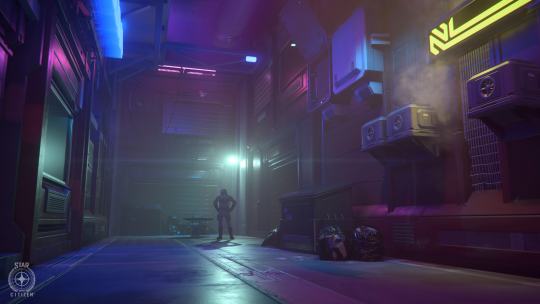
Last week, we updated the public roadmap with content all the way up to Alpha 3.9, where we’ll be flying Vultures to Crusader and beyond. If you missed the latest update, take a look, as progress for these new features will start appearing in your monthly reports soon enough.
AI – Character
We start with Character AI, who spent the month making general improvements, firstly to combat behaviors to make it easier for the team to assign different tactics to different characters. This work happily fixed a few bugs with vision perception and cover selection too. Secondly, NPC locomotion saw the integration of the collision avoidance system into smooth locomotion, which now takes into consideration the edge of walkable navigation areas.
Naturally, bug fixing, stability fixes, and optimizations were also done for Alpha 3.5.
AI – Ships
Ship AI implemented new pilot skill levels to vary the agility of enemy ships and determine how they balance self-preservation and aggression. Improvements were also made to how non-player traffic behaves around landing zones.
AI – Social
The Social AI Team finished the first pass of ‘scooching’, which made its monthly report debut last month. If you missed it, scooching enables a character to fluidly move from one action to another within a group of useables.
Design supported the set up of the bartender/vendor character by providing necessary tech pieces where needed. Optimization started on usables, including the caching of usable entries and TPS query time-slicing.
Animation
March saw Animation readying mission-giver Tecia Pacheco for her Alpha 3.5 debut and finishing the animation sets for Recco Battaglia and the ship dealers. They also implemented new female emotes and brought the male versions up to the current quality standard, which included stopping a plague of different technical issues.
Focus was also on two big-ticket items: developing the final jump system and the female playable character. Finally, the team worked on the combat AI system, adding new weapon options for enemies to use against the player.
Art – Characters
Character Art were one of the many teams collaborating on Alpha 3.5’s facial customizer. This coincided with the adding of the female playable character into the game and creating new armors wearable by both sexes (which will continue into the foreseeable future). Tecia Pacheco’s hair was tidied up before launch and the few non-Alpha-3.5-related hours were spent refining the hair creation pipeline.
Art – Environment
Many Environment Art devs devoted the month to Alpha 3.5, making quality-of-life improvements, bug fixing, and polishing assets. Several locations, including Hurston and Lorville, were refined and tweaked to give an overall improved visual experience. The ongoing planet tech development rolls on too, with current efforts becoming the foundation of wider improvements coming later in the year. The team are also looking into ways to better scale natural features like canyons, with first tests looking promising.
The final touches were added to ArcCorp ahead of its big release, with huge strides made early in the month when Area18, Riker Spaceport, and the surrounding city received finalized textures, materials, and finishes. While the planet was ‘content complete’ a while ago, the last stages of development saw countless optimization tasks completed to make it good enough for players to explore. The final level of detail (LOD) tweaks were completed to enable the assets to perform well in-engine, along with other technical aspects like tweaking view distance ratios, altering vis-areas, and merging meshes. Art of distant buildings and advertising added the final touch to the city’s vistas.
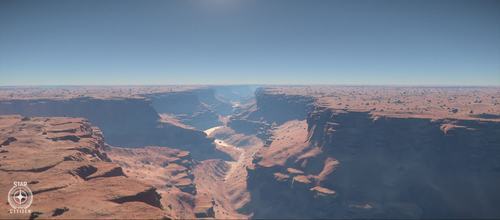

Art – Tech
Tech Art worked on the user interface for Character Customizer v2, which will see the light of day in Alpha 3.6. While the current version gives users all the required functionality, the process can be thoroughly streamlined through a number of layout and functionality amends. These changes have been prototyped and are awaiting implementation by the Gameplay Team.
Tasks towards extending the character creation ‘DNA gene pool’ were also completed, which will eventually increase the number of heads the user can choose from and blend together. While still being significantly fewer than the planned final amount, the enhanced pool will give players much greater variety compared to the nine heads per male and female available in Alpha 3.5.
Alongside customization, they fixed a few weapon-related bugs for both dev builds and Alpha 3.5, such as wrongly-oriented attachments, broken or missing animations, and a tagging issue causing the player character to be assigned the wrong animations. They supported Weapon Art with rigging and engine setup for several upcoming releases and worked with Animation and AI Programming on the first implementation of the new usable system.
Audio
Alpha 3.5 features the new flight model, the development of which presented an unmissable opportunity to expand on the ship audio experience. Improvements include new sound effects for strain and vibration, afterburners, maneuvering thrusters, and atmospheric flight. They also include accurate point source sound emitters and general improvements to the overall design, implementation, and mix.
Naturally, attention was given to ArcCorp and Area18, with new environmental dialogue, music, and sound effects implemented to contribute to the overall sense of a thriving metropolis. These include PA announcements, diegetic music, spot ambiance effects, dynamic advert audio, and systemic planetary ambiances. The team’s work is again complemented by the brilliant ArcCorp music cue from composer Pedro Camacho.
Audio was also produced for the Kastak Arms Coda pistol, Gemini S71 assault rifle, Xi’an Kahix rocket launcher, and Banu Tachyon ship cannon.
Finally for Audio, notable developments were made to the Foley system, including better footstep material recognition, redesigned depressurized footsteps, and varying footstep effects dependant on character heaviness and footwear. The Foley sound effect sync was improved when running too, as were collision sounds when rag-dolling.
Backend Services
Throughout the past month, Backend Services supported Alpha 3.5, fixed various bugs, and adjusted backend-supported features. On the main development front, great progress was made on the GIM rewrite, with the new matchmaker successfully tested internally. The GIM’s internal match/group management system also came to life. These changes are significant because, rather than being code existing inside the legacy GIM application, they are now individual and highly fault-tolerant services that can be scaled as the project develops.
Another major change was the introduction of the variable service, which came with a surprisingly high volume and rate of data.
One of the team’s goals this month was to provide much needed insight and analytics on various types of data coming from the DGS. So, a new system was created to track the rate of individual DGSs along with information about specific variables, enabling the team to fine-tune how data is serialized and how often it’s pushed to the backend.
The first major part of the iCache has been completed and tested internally, too. The iCache is a highly distributed and fault-tolerant storage/query engine that greatly out-performs the current pCache. It provides an indexing and query system that can be utilized by other services for specific and complex item queries. This system is important going forward, particularly as the Persistent Universe sees greater volumes of players and server meshing comes online.
Community
The community celebrated St. Patrick’s Day (or Stella Fortuna!) with a screenshot contest calling for in-game party pics. Plenty of outstanding images of memorable moments were received, but there were only three pots of gold to hand out – the lucky winners taking home a Constellation Phoenix Emerald, Mustang Delta, and Ursa Rover Fortuna.
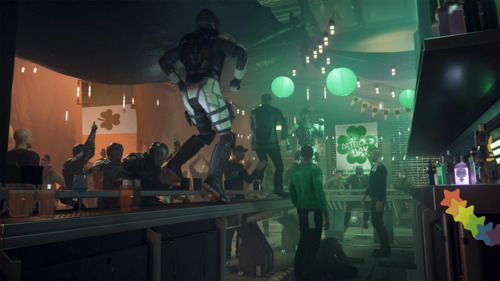
March saw the unveiling of the multi-crew explorer, the Corsair. Should any prospective pathfinders be unsure whether they want to sail the stars in Drake’s latest, the recently released Q&A should help. Jump Point, the monthly subscriber-only magazine, took an even deeper dive into the Corsair’s design process along with a behind-the-scenes look at the new character customizer, a Whitley’s Guide on MISC’s Reliant series, and more.
Shouts of ‘Triggerfish!’ could be heard across the ‘verse when we announced our first new merchandise offerings of 2019 on April 1st: The Scents of Star Citizen collection. Classic fragrances of the past meet the mysterious essence of the future in Quantum, an innovative cultivation that transcends space and time.
Content – Vehicles
While the Vehicle Content Team predominantly focused on the three MISC Reliant variants and continuing work on the 300 series, they found time to work with Animation on a better system for setting up character ship entry and exit animations. The also tackled a variety of vehicle bugs leading up to the release of Alpha 3.5.
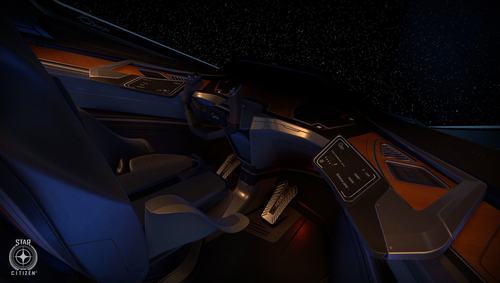
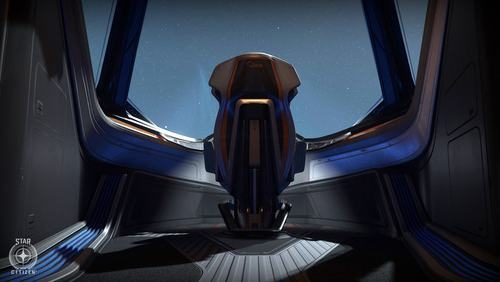
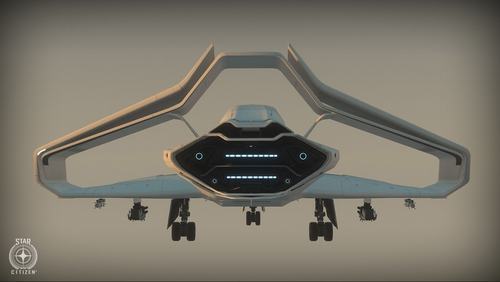
Design
Design’s focus throughout March was on Area18, which included adjusting the AI, usables, stores, and more. Tecia Pacheco was given a design pass, while a new team member was inaugurated with tasks to improve both the Emergency Communication Network (ECN) and NPC spoofing missions (where NPCs send out service beacons asking for help).
Regarding the in-game economy, a system built to create a robust and modular representation of item variance was polished and is now ready when needed. Inventories were also added to all new locations, including the new Alpha 3.5 weapons and items created by the Weapons Team.
DevOps
The culmination of this year’s first publishing cycle was especially busy for DevOps. The team publish internal builds every day of every month for internal testing, but demand increases drastically when additional publishes are needed for the Evocati and PTU. As the game grows, so does the complexity of deployments and the reporting requirements, with this month seeing a 69% increase in build activity. Most of this is due to the ‘feature streams’ that the team have worked on for the past few months, which isolate features from each other during development to avoid collision.
Engineering
The Engine Team supported Alpha 3.5 with extensive profiling, optimization, bug fixes, and improvements to help Sentry, the PU crash database, better analyze and catalog existing issues.
Rendering wise, they continued work on Temporal Sample Antialiasing (TSAA) with general quality improvements that translate to less flickering and a sharper picture. They also adjusted the TSAA bicubic filter based on frame time to prevent the accumulation of ringing artifacts at high framerates. For hair, they added an experimental option for custom tangents, removed the temporary scatter model, moved the hair mask to variation map alpha, improved edge masking, and added card support for the hair physically-based rendering (PBR) shader. For planetary ground fog (currently scheduled for Alpha 3.6), they refined the proxy mesh tessellation and moved pre-tessellation to jobs, did the first ray marching test and implementation, refined modeling of the fog gradient over terrain, and spent time rectifying floating point precision issues.
They also completed rendering support for CPU-accessible textures for RTT video comms calls and optimized shaders to avoided unnecessary resource creation (e.g in GPU skinning). The Initial ImGUI integration was completed and will be used to unify and improve the in-game profiling tools. System and module integration were added to avoid an unorganized collection of tools and a text/tag searchable configuration system for registered tools (similar to visual code) was implemented. To better improve load times, the team created a new load time profiler to track file access (times accessed, data transfer, etc.), amended the IO scheduler for SSDs and HDDs to give faster load times and response, and vastly improved file access in the shader system to speed up initialization at start-up.
In addition to the compile-time analysis tool developed last month, they finalized an add-in tool to generate optimal uber file sets and, as a result, reshuffled game uber files for even better compile times.
Work also began on a physics debugger that will allow the team to record issues, play them back, freeze time, etc. to help understand and speed up fixing complex physics issues.
Features – Gameplay
Throughout March, most of the team dedicated their time to working with the Character Team on the customizer, including the design flow, user interface, and the implementation of the female playable character. The rest focused on implementing comms video streaming improvements. All of the team’s work this month made it into the Alpha 3.5 build, so can be seen by anyone in the Persistent Universe.
Features – Vehicles
Improvements to gimbaled weapons were finished for Alpha 3.5 and the radar and scanning systems received a polish, including the implementation of focus angle and ping fire. Under-the-hood progress was also made with vehicle item port tech, specifically with the vehicle .xml migration to Data-Forge. March’s final stretch was spent fixing game crashes and bugs for the upcoming release.
Graphics
Alongside visual tweaks and fixing stability issues for Alpha 3.5, the team better aligned the sun and shadows with fog in large spaces (such as hangars) and fixed a persistent glitch with indoor lights. For vid-comms and general render-to-texture, the teams fixed a few issues that were interfering with brightness along with intermittent cases where lights on holograms were disappearing. They also switched most holographic scenes over to a forward-shaded render pipeline to improve efficiency.
Graphics also got in on the gas cloud feature by supporting Design, adding the ability to rotate tunnel pieces, and creating a more intelligent streaming system to enable them to lay out large sections of the game without running over the memory budget.
Level Design
The Level Design Team barreled on with Area18, fixing bugs and generally preparing it for its unveiling. This included a lot of playtesting and tweaking of the room-system, landing areas, transit system, and more.
Planning began for the upcoming procedural tool and next set of procedural space stations. Prototyping was done on cave layouts and potential gameplay was ideated in close cooperation with the Environment Art Team. There were also updates to Lorville, with the addition of small and medium hangars and a new transit line between Teasa Spaceport and the Central Business District (CBD).
Lighting
Like many others, Lighting almost entirely dedicated their month to finalizing Area18, which required collaboration with a lot of other teams. Particularly, they worked with Props and Environment Art in the final push to raise the visual standard and unify the look across the wider landing zone. Performance is always a concern, so special attention was paid to ensuring the maximum lighting quality was achieved within the defined frame budgets. After lessons were learned during the development of Lorville, the team were able to optimize the new location’s lighting far more efficiently.
Aside from Alpha 3.5, Lighting had a hand in the development of the character customizer by providing a clean, high-quality lighting rig for the UI. They also supported the reworking of the Echo 11 Star Marine map, providing additional polish, optimization, and clean-up.
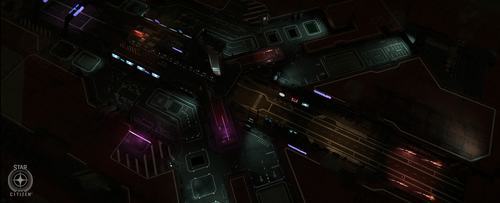
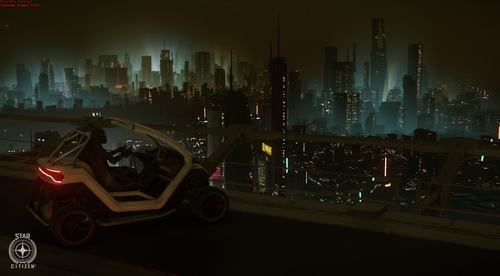
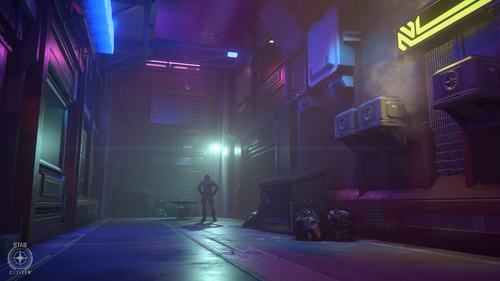
Narrative
In March, Narrative worked with Design to identify the production nodes and manufacturing locations of all of Star Citizen’s corporations for the expanding economy system. This led to a review of the item inventories of Stanton’s shops to make sure stores were carrying items appropriate for their location. The team also worked on generating names for various vehicles, including the Ursa Rover Fortuna.
Narrative filled Area18 with a variety of posters, ads, and props to flesh out the lore of Stanton’s newest landing zone. They also worked with the Live Design Team to support mission content for Tecia Pacheco. Finally, Alpha 3.5 will also provide a first look at the new Banu language that is being developed, so keep an eye out for more info on that.

Player Relations
Player Relations were busy throughout March supporting the Evocati and players smash bugs in the PTU. Initially, they worked alongside the Evocati for several builds to test out the new flight model. Once it was stable, they added Concierge and Subscribers to test out the other key features. Eventually, all backers were welcomed into the PTU before Alpha 3.5’s wider release.
“We say it every month, but we can’t thank our volunteers enough for the wonderful efforts they put into helping us build this game (especially you Avocados!).”
Props
At the start of March, the Props Team took Area18’s assets from the ‘modeling complete’ phase through to ‘final art’, which included the technical set up, LODs, prefab setup, and bug fixing. They reached ‘content complete’ status half-way through the month before heading into the final polish pass. The area’s food carts were pushed a little further with branding and dressing prop variation, while the lighting was separated out to give the Lighting Team more control. Updates were also made to older street furniture to bring it up to standard and the team helped with the branding and signage assets used throughout the level.
With persistent habs included in Alpha 3.5, a pass was completed to convert a whole host of props from static objects to interactive entities, while hand grip was set up to work with the player animations and additional physics set up.
The team also took a pass at the Spectrum Unlimited kiosk, creating additional dressing, props, and magazines. The month was rounded off with a final bug-fixing pass and, of course, turtles.
QA
QA’s testing focus was on feature integration for the Alpha 3.5 branch. They tested all the new content such as ArcCorp and its moons, Area18, the character customizer, female playable character, Origin 300i rework, and Reliant Variants. In addition, stability and performance testing ramped up in anticipation of the release and included daily performance captures to help narrow down and fix performance-related issues.
The AI feature testers in Frankfurt worked hard to stay on top of the various issues that cropped up with the addition of new mission givers and changes to collision avoidance. The embedded tester for the Transit Team was kept busy debugging various low repro issues that seemed to be tied to server performance and caused issues such as players falling through floors and Lorville’s trains not turning up. Memory corruption testing is currently ongoing to help track down crashes that occur randomly during normal gameplay. This testing is being done in the PTU using custom binaries provided by the Engine Team.
Ship Art
Lead Vehicle Artist Chris Smith completed the refactor of the Origin 300i and spent quite a bit of time getting the components modeled. He has now officially moved onto a new ship, which is currently in the whitebox phase.
3D Modeler Josh Coons continues his work on the Banu Defender and is working diligently to complete the greybox stage. Since everything on this ship is brand new and almost nothing is re-used from other ships, he is being assisted by Associate Vehicle Art Director Elwin Bachiller to ensure it’s completed in time.
System Design
The System Design Team finalized the current iteration of the no-fly zones around Area18 and ArcCorp, which required new features to be added to allow it to work at the scale required. Walla and Lyria both received their share of mining resources, with Walla getting unique Atacamite geode deposits. They also finalized their work on the unification of the vendor/bartender AI, which will allow the same behavior to serve drinks at a bar and give players items from a shelf and weapons from a rack.
Turbulent
Turbulent supported the Alpha 3.5 features promotion, which highlighted character customization, ArcCorp, and the new flight model. They also supported St. Patrick’s Day, which featured the new Ursa Rover Fortuna and a screenshot contest.
The CMS backend migration continued and was deployed to the PTU (the changes will appear in the live environment within the next few weeks).
Voice servers received an upgrade which will benefit from RTCP (data channel) improvements and enable active speaker detection in comms channels. The security of voice channels has also been improved. The Services Team continued working on video streams in comms channels in order to improve long-distance calls, too.
Turbulent’s upcoming Game Admin tool will support game designers as well as the Player Relations Team by providing key statistics as well as granular technical information on groups, lobbies, and voice channels. The design is now done and development has started on its first functionality, the general information display.
Finally from Montreal, the Game Services Team continued working on the new framework that will impact all upcoming development of Star Citizen services. Thanks to this core modification, services including group, lobby, and voice channel will be more standardized and upcoming development milestones will be reached quicker.
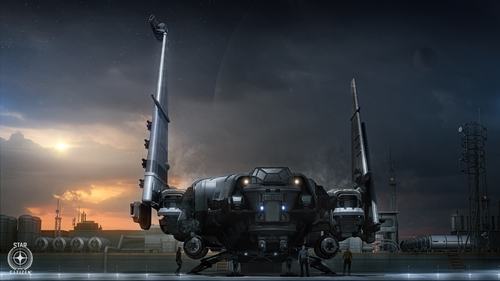
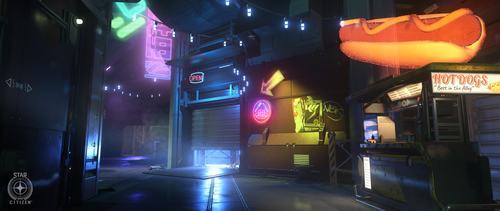

UI
Last month, UI finalized the in-fiction advertisements and branding for ArcCorp and Area18. They progressed with the area map, including the ability to visually distinguish between different floors of an interior. As release day drew closer, they worked on various optimizations and bug-fixing.
Vehicles
This month, the Global Vehicle Team put the finishing touches to the Alpha 3.5 ships and steadily progressed with those beyond the latest release:
The largest sub-team is focused on the Origin 890 Jump, which has just completed the greybox stage and is now heading into the final art phase. Work is progressing on the Carrack, which now has the whole of the engineering section in the rear done to greybox and the habitation deck is only missing the captain’s quarters to be greybox complete. The Vanguard series is heading to the final art stage, with the rear section and cockpit both receiving a pass. The exterior is up next. Greybox of the Banu Defender rolls on, while the Character Concept Team was called on to build a foundation for the Tevarin species that will be used to help design the Esperia Prowler.
Finally, pre-production began on the P52 Merlin update, P72 Archimedes, and the Esperia Prowler.
VFX
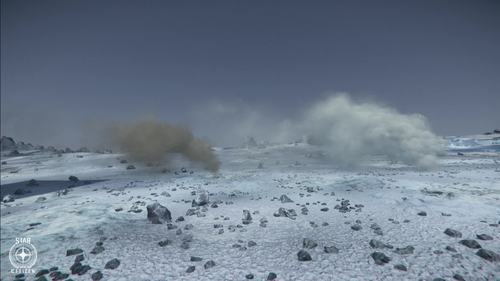
The VFX Team rolled out their recent GPU particle lighting changes, which includes a new optional specular shading model for particles. This multiplies the level of lighting the particle receives from the cube maps, causing it to sit within the environment more realistically. In the photo below, the left smoke effect uses the old lighting (without specular shading), while the right uses the new system.
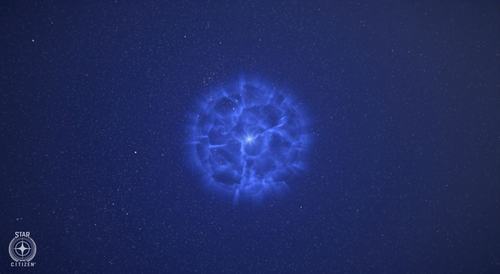
The team is currently looking at some of the older effects in the game and are reworking them to take advantage of the updated systems, such as the EMP, which was added some time ago and has since degraded due to issues with the old particle system.
Regarding weapons, the team polished and optimized the new ballistic pistol and assault rifles and took the first pass at the Tachyon cannon; a brand-new weapon type that was in its R&D phase last month.
On the ship side, the reworked 300i had a full VFX pass. Finally, as is usual in the run-up to a release, the team began their twice-weekly playtests, from which a fairly large ‘snag list’ was created and fixed.
Weapons
The Weapon Art Team started work on the Apocalypse Arms Animus missile launcher, the Klaus & Werner Lumin SMG, and new upgrade levels for various ship weapons.
Conclusion
WE’LL SEE YOU NEXT MONTH…
$(function() { Page.init(); window.Page = new RSI.Game.About(); }); http://bit.ly/2X4CWSB
0 notes
Text
How to install tp-link router tl-wr840n
Tp-link router tl-wr840n is specifically designed to meet the internet requirements of home and small business. Tl-wr840n offers advanced and exceptional wireless performance which makes this router superior from the other available options. Tp-link router tl-wr840n is ideal to use for the streaming of HD videos, online gaming, and VOIP. It also includes the WPS ( WIFI Protected Setup) button which makes sure that the network is secure from any kind of outside intrusions. Sometimes inside the router speed issue creates a hindrance in the functioning of a router. To tackle these issues Netgear wifi Extender setup team will be there to help you out anytime.

System requirements:
Windows 2000/7/8/XP/Vista or Linux-based operating system or Mac OS.
To set up and Install the link router tl-wr840n, follow the below-mentioned steps. :
Unbox the router and turn on the device. The device might take 1 minute or less to get turned on.
On the backside, you will see 5 port, out of which 1 is for broadband cable and the other ports are for LAN connectivity.
In your laptop, you can see the network name as TP-Link to which you have connected.
Click on ‘connect’ to connect the router. You will be asked to enter the security key to get connected. You can find the security key behind your router.
Enter the security key to get connected to the network.
For configuration, open the web browser and enter the address as “198.168.0.1” and click ok.
You will be asked to enter the username and password, by default both are “admin”.
Now you can see the quick setup for router configuration.
Click on Next, step by step to go to the next section.
You have to choose the IP type, if you have the dynamic IP, then choose dynamic IP and if you have static Ip then select the static IP.
·Click on Next. here you can see the error that cable is unplugged. Connect the cable.
Put the IP address manually.
Click on Next. Now, you can change the Network name. Fill the required necessary details and click on Next.
In the next page, you can see the congratulation message. Click on finish to complete the process.
So by following these steps installation of the router can be done, but in case of any issue persists then contact the Netgear Wifi Extender Setup team. Our certified experts will be there for you 24 X 7 to help you out.
0 notes
Link
0 notes
Text
Quick Steps For TP-Link Extender Setup
The tp-link extender setup process begins with accessing the login page and then getting to the setup wizard so you can change the extender settings. For help with the extender setup process, you can always reach out to the team who would help you with the complete details related to the setup and login process.
0 notes
Link
Get complete details on tplink extender setup
You can either use a web browser method or WPS method to configure tplink extender. the tplink extender setup process does not take much time. But in case, you need complete details on how do I connect my tp link extender, you can perform a live chat with our team or you can call them on their toll-free number.
https://www.cperepeatersetup.net/tplink-extender-setup/
#tplinkrepeater.net#tplink cpe extender setup#tplink cpe repeater login#tplink cpe setup#tplink cpe extender login#tplink cpe login
0 notes
Text
Wi-Fi Booster Market 2018 Research Analysis and Potential of Market from 2018-2023
Market Highlights
The study reveals that the global Wi-Fi booster market is adopted in the various outdoor solution in North America region. This is due to the establishing an intelligent transport system within the region. The wi-fi booster has huge market in these region due to the long reach, fast throughput and easy setup. The boosters are being widely used for the communication that speed up of the extended Wi-Fi, better performance and security while communications.
In North America region, the wi-fi booster is gaining momentum in the marine & aerospace segment. These devices allow to connect to the wireless network, or access to the other devices to extend a network bandwidth. The wifi booster amplifies the network by boosting the WiFi signal. The major player including Netgear (U.S.), Linksys (U.S.) have released the new product of wifi booster.
The global Wi-Fi booster market is growing rapidly over ~18% of CAGR and is expected to reach approximately USD 3 Billion by the end of forecast period.
Taste the market data and market information presented through more than 30 market data tables and figures spread over 100 numbers of pages of the project report. Avail the in-depth table of content TOC & market synopsis on “The Wi-Fi Booster Market Research Report -Forecast to 2023”.
Get Free Sample Copy of Report @ https://www.marketresearchfuture.com/sample_request/4037
Key Players
The prominent players in the global Wi-Fi booster market are – Netgear, Inc. (U.S.), Ruckus Wireless, Inc. (U.S.), Juniper Networks (U.S.), Motorola Solutions, Inc. (U.S.), Cisco Systems, Inc. (U.S.), Alcatel-Lucent S.A. (France), Aruba Networks (U.S.), Ericsson (Sweden), D-Link Corporation (Taiwan) and TP-Link (China), among others.
Wi-Fi Booster Market Segmentation
The Wi-Fi Booster Market has been segmented on the basis of type, services, solution and region. The Wi-Fi booster contains detailed analysis with market size of each segment. The type segment includes indoor and outdoor. The Services segment includes installation, support & maintenance, network design. The solution segment includes residential solution, enterprise solution, marine & aerospace solution and outdoor solution and the region segment includes North America, Europe, Asia Pacific and rest of the world.
Market Research Analysis:
Global Wi-Fi Booster market, by region has studied in different regions as Americas, Europe, Asia-Pacific and Rest of world. North America is leading with the highest market share as companies are investing in the Wi-Fi Booster devices. Europe is expected to reach at the high peak in the coming years as the wifi booster provides speed up and easy management via mobile app. While, APAC regions has the highest CAGR in the Wi-Fi Booster market and projected towards the growth in forecast years.
Intended Audience:
Wi-Fi booster manufacturing companies
Original equipment manufacturers
Wi-Fi booster providers
Research and development companies
Market research and consulting firms
Solution providers
Technology standards organizations
Technology investors
System Integrators
Get complete Report @ https://www.marketresearchfuture.com/reports/wi-fi-booster-market-4037
TABLE OF CONTENTS
List Of Tables
Table 1 Global Wi-Fi Booster Market, By Component, 2017-2023 (Usd Million)
Table 2 Global Wi-Fi Booster Market, By Solution, 2017-2023 (Usd Million)
Table 3 Global Wi-Fi Booster Solution Market, By Type, 2017-2023 (Usd Million)
Table 4 Global Wi-Fi Booster Market Services, By Services 2017-2023 (Usd Million)
Table 5 Global Wi-Fi Booster Market Services, By Type 2017-2023 (Usd Million)
Table 6 Global Wi-Fi Booster Market, By Type, 2017-2023 (Usd Million)
Table 7 Global Indoor Wi-Fi Booster Market, By Component, 2017-2023 (Usd Million)
Table 8 Indoor Wi-Fi Booster Market, By Region, 2017-2023 (Usd Million)
Table 9 Outdoor Wi-Fi Booster Market, By Component, 2017-2023 (Usd Million)
Table 10 Outdoor Wi-Fi Booster Market, By Region, 2017-2023 (Usd Million)
Table 11 Global Wi-Fi Booster Market, By Region, 2017-2023 (Usd Million)
Table 12 North America Wi-Fi Booster Market, By Country, 2017-2023 (Usd Million)
Table 13 North America Wi-Fi Booster Market, By Type, 2017-2023 (Usd Million)
Table 14 U.S. Wi-Fi Booster Market, By Type, 2017-2023 (Usd Million)
Table 15 Canada Wi-Fi Booster Market, By Type, 2017-2023 (Usd Million)
Table 16 Europe Wi-Fi Booster Market, By Country, 2017-2023 (Usd Million)
Table 17 Europe Wi-Fi Booster Market, By Type, 2017-2023 (Usd Million)
Table 18 Germany Wi-Fi Booster Market, By Type, 2017-2023 (Usd Million)
Table 19 France Wi-Fi Booster Market, By Type, 2017-2023 (Usd Million)
Table 20 U.K. Wi-Fi Booster Market, By Type, 2017-2023 (Usd Million)
Continued…
Know More about this Report @ http://www.abnewswire.com/pressreleases/wifi-booster-market-2018-emerging-technologies-gross-margin-analysis-sales-revenue-business-growth-regional-trends-future-plans-and-industry-estimated-to-rise-profitably-by-2023_303830.html
About Us:
At Market Research Future (MRFR), we enable our customers to unravel the complexity of various industries through our Cooked Research Report (CRR), Half-Cooked Research Reports (HCRR), Raw Research Reports (3R), Continuous-Feed Research (CFR), and Market Research & Consulting Services.
Media Contact:
Market Research Future
Office No. 528, Amanora Chambers
Magarpatta Road, Hadapsar,
Pune - 411028
Maharashtra, India
+1 646 845 9312
Email: [email protected]
0 notes
Link
Learn how to set up tplink extender
You must complete the tplink extender setup to expand the coverage area of your wireless network. You can complete the tp link extender setup by using the web browser method or WPS method. To get more details on both the methods of tp link extender installation and configuration, you can get connected with our team.
https://tp-linkrepeatr.net/tp-link-extender-setup-instructions/
#tplink extender login#tplink login page#tplinkextender.net#tplink extender setup#tplink setup wizard#tplinkrepeater.net#tplink repeater login
0 notes
Link
AC1750 Wi-Fi Extender Setup
The AC1750 Wi-Fi Extender Setup is essential as it is the way you can customize its several settings. So, you can use the WPS method or a web-based method to set up your TP-Link wifi router. For complete details about the tplink setup process, click here.
#tplinkrepeater.net#tplinkextender.net#tplink extender setup#tplink repeater setup process#tplink extender setup page
0 notes